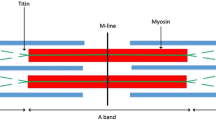Abstract
Addition of 2 mM NiCl2/l or CoCl2 to a normal Tyrode solution containing 1,8 mM Ca++/l can completely abolish the contractility of isolated guinea pig's papillary muscles without reducing the duration of the electrical excitation process. This effect can be fully explained by the assumption of a competitive antagonism between Ca++ and these other bivalent cations on the contractile machinery. Therefore, even in the presence of Ni++ or Co++, excitation-contraction coupling is completely restored by excess Ca++ (2–4 mM/l) within a few minutes. In contrast to these highly specific functions of Ca++ in initiating the contractile events, replacement of Ca++ by Ni++ or Co++ on the excitable surface membrane of the myocardial fibres does not lead to clear symptoms of Ca++ deficiency as, for instance, to an abbreviation of action potential. Here, Ni++ or Co++ can even substitute Ca++ by maintaining the normal shape of action potential in a Ca++-deficient medium.
Similar content being viewed by others
Literatur
Davies, R. E.: A molecular theory of muscle contraction. Nature (Lond.) 199, 1068–1074 (1963).
Frank, G. B.: Utilization of bound calcium in the action of caffeine and certain multivalent cations on skeletal muscle. J. Physiol. (Lond.) 163, 254–268 (1962).
Garb, S.: The effects of potassium, ammonium, calcium, strontium and magnesium on the electrogram and myogram of mammalian heart muscle. J. Pharmacol. exp. Ther. 101, 317–326 (1951).
Grossman, A., and R. F. Furchgott: The effects of external calcium concentration on the distribution and exchange of calcium in resting and beating guinea pig auricles. J. Pharmacol. exp. Ther. 143, 107–120 (1963).
—— —— The effects of frequency of stimulation and calcium concentration on Ca45 exchange and contractility on the isolated guinea pig auricle. J. Pharmacol. exp. Ther. 143, 121–130 (1963).
Huxley, H. E.: The Cell, Vol. IV, chap. 7. Muscle cells. New York and London: Academic Press 1960.
Langer, G. A., and A. J. Brady: Calcium flux in the mammalian ventricular myocardium. J. gen. Physiol. 46, 703–719 (1963).
Thomas, L. J.: An antagonism in the action of calcium and strontium ions on the frog's heart. J. cell. comp. Physiol. 50, 249–264 (1957).
Winegrad, S., and A. M. Shanes: Calcium flux and contractility in guinea pig atria. J. gen. Physiol. 45, 371–294 (1962).
Author information
Authors and Affiliations
Additional information
Mit 4 Textabbildungen
Rights and permissions
About this article
Cite this article
Kaufmann, R., Fleckenstein, A. Ca++-kompetitive elektro-mechanische Entkoppelung durch Ni++- und Co++-Ionen am Warmblütermyokard. Pflügers Arch. 282, 290–297 (1964). https://doi.org/10.1007/BF00412717
Received:
Issue Date:
DOI: https://doi.org/10.1007/BF00412717




